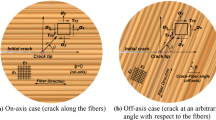Abstract
Mode I fracture characterization was performed in wood using the single-edge-notched beam loaded in three-point-bending (SEN-TPB). A data reduction scheme based on equivalent linear elastic fracture mechanics concept was used to evaluate the Resistance-curve instead of classical methods. The method is founded on assessment of an equivalent crack from specimen compliance using beam theory and the existence of a stress relief region in the crack vicinity. Crack length monitoring is unnecessary during the loading process, providing a complete Resistance-curve which is essential for a clear identification of the fracture energy. Experimental results were obtained from fracture tests involving geometrically similar SEN-TPB specimens of different sizes. It was observed that the smallest tested specimen is inadequate to estimate the fracture energy due to fracture process zone confinement. Contrarily, the other two are suitable for such purpose. An inverse method was used to determine a bilinear cohesive law representative of wood material fracture. It was concluded that a unique cohesive law is able to mimic the fracture behaviour of considered specimen sizes.










Similar content being viewed by others
References
Bažant ZP, Kazemi MT (1990) Size effect in fracture of ceramics and its use to determine fracture energy and effective process zone length. J Am Ceram Soc 73:1841–1853
Beer P, Sinn G, Gindl M, Tschegg S (2005) Work of fracture and of chips formation during linear cutting of particle-board. J Mater Process Tech 159:224–228
Boström L (1994a) Application of the fictitious crack model to the compact tension specimen. Wood Sci Technol 28:319–327
Boström L (1994b) The stress-displacement relation of wood perpendicular to the grain—part 1. Experimental determination of the stress-displacement relation. Wood Sci Technol 28:309–317
Coureau J-L, Morel S, Dourado N (2013) Cohesive zone model and quasibrittle failure of wood: A new light on the adapted specimen geometries for fracture tests. Internat J Solids Struct. 109:328–340
Daudeville L (1999) Fracture in spruce: experiment and numerical analysis by linear and non linear fracture mechanics. Holz Roh Werkst 57:425–432
de Moura MFSF, Morais J, Dourado N (2008) A new data reduction scheme for mode I wood fracture characterization using the double cantilever beam test. Eng Fract Mech 75:3852–3865
de Moura MFSF, Dourado N, Morais J (2010) Crack equivalent based method applied to wood fracture characterization using the single edge notched-three point bending test. Eng Fract Mech 77:510–520
Dourado N, Morel S, de Moura MFSF, Valentin G, Morais J (2008) Comparison of fracture properties of two wood species through cohesive crack simulations. Compos Part A Appl S 39:415–427
Dourado N, de Moura MFSF, Morais J (2011) A numerical study on the SEN-TPB test applied to mode I wood fracture characterization. Internat J Solids Struct 48:234–242
Franke B, Quenneville P (2014) Analysis of the fracture behavior of Radiata Pine timber and Laminated Veneer Lumber. Eng Fract Mech 116:1–12
Fruhmann K, Burgert I, Stanzl-Tschegg SE, Tschegg EK (2003) Mode I fracture behaviour on the growth ring scale and cellular level of spruce (Picea abies [L.] Karst.) and beech (Fagus sylvatica L.) loaded in the TR crack propagation system. Holzforschung 57:653–660
Guitard D (1987) Mécanique du matériau bois et composites. Cépaduès Éditions. ISBN 2.85428.152.7: 108-23
Gustafsson PJ (1988) A study of strength of notched beams. In: Proceedings of CIB-W18A meeting. Parksville, Canada
Kienzler R, Herrmann G (1986) An elementary theory of defective beams. Acta Mech 62:37–46
Majano-Majano A, Hughes M, Fernandez-Cabo JL (2012) The fracture toughness and properties of thermally modified beech and ash at different moisture contents. Wood Sci Technol 46:5–21
Morel S, Dourado N, Valentin G, Morais J (2005) Wood: a quasibrittle material—R-curve behavior and peak load evaluation. Int J Fracture 131:385–400
Morel S, Lespine C, Coureau J-L, Planas J, Dourado N (2010) Bilinear softening parameters and equivalent LEFM R-curve in quasibrittle failure. Internat J Solids Struct 47:837–850
Petersson PE (1981) Crack growth and development of fracture zone in plain concrete and similar materials. Report No. TVBM-1006, Division of Building Materials, Lund Institute of Technology. Lund, Sweden
Reiterer A, Sinn G, Stanzl-Tschegg SE (2002) Fracture characteristics of different wood species under mode I loading perpendicular to the grain. Mat Sci Eng A Struct 332:29–36
Stanzl-Tschegg SE, Tan DM, Tschegg EK (1995) New splitting method for wood fracture characterization. Wood Sci Technol 29:31–50
Yoshihara H, Kawamura T (2006) Mode I fracture toughness estimation of wood by DCB test. Compos Part A Appl S 37:2105–2113
Yoshihara H, Satoh A (2009) Shear and crack tip deformation correction for the double cantilever beam and three-point end-notched flexure specimens for mode I and II fracture toughness measurement of wood. Eng Fract Mech 76:335–346
Author information
Authors and Affiliations
Corresponding author
Rights and permissions
About this article
Cite this article
Dourado, N., de Moura, M.F.S.F., Morel, S. et al. Wood fracture characterization under mode I loading using the three-point-bending test. Experimental investigation of Picea abies L.. Int J Fract 194, 1–9 (2015). https://doi.org/10.1007/s10704-015-0029-y
Received:
Accepted:
Published:
Issue Date:
DOI: https://doi.org/10.1007/s10704-015-0029-y




